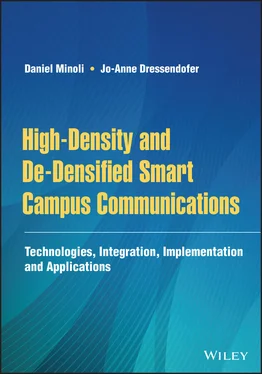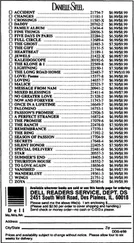
FIGURE 1.2 A gate area at Fort Lauderdale‐Hollywood International Airport is crowded with travelers awaiting Delta flight 1420 to Atlanta Saturday, 14 March 2020.
(Courtesy: John Scalzi, Photographer).
1.2.2 Pre‐pandemic/Long‐term Requirements for Stadiums
For stadiums, a target of one million connections per square kilometer (also definable as 1 connection per m 2or one connection every 10 ft 2) has been suggested by some researchers [2]. In the bleachers, the density could be high, even multiple individuals (say 2–3) every 10 ft 2. Requirements include high‐capacity data and video access, IoT automation support, which also includes surveillance. The requirements are generally consistent with Table 1.2, with the coverage extending to parking lots. The services span more tightly defined time intervals (as contrasted to airports), possibly giving rise to a challenge in achieving certain goals for the Return on Investment on the infrastructure and the core‐network connectivity. The communication session may span the entire sporting event and a specified interval before and after the event.
A football field encompasses 57 600 ft 2(1.32 acres) but the bleachers may extend the area of coverage to two acres; the parking lots can cover several acres, but the traffic is sparser. Indoor sporting arenas could be smaller. The largest US stadium is the Michigan Stadium in Ann Arbor, Michigan, that seats about 115 000 spectators – about 10 stadiums in the United States can seat over 100 000 people. There are about 90 football stadiums that seat between 50 000 and 99 999 people, and there are about 50 stadiums that seat between 28 500 and 49 999 people. See Table 1.4. There are many other types of sporting venues (e.g. basketball courts, baseball fields, hockey arenas, soccer fields). Soccer field dimensions are somewhat wider than the regulation American football field, being 100–110 m long and 64–73 m wide.
1.2.3 Pre‐pandemic/Long‐term Requirements for Convention Centers
A target of one million connections per square kilometer (also definable as 1 connection per m 2or 1 connection every 10 ft 2) appears appropriate. The KPI are comparable to those of Table 1.2for both people and M2M/IoT functionality. Connectivity is to be supported for both the booth exhibitors (which sometimes can be rather complex) as well as the visiting public. Often there is also a video broadcasting function among specialized media outlets that may need to be supported. Since visitors are engaged with the goings‐on in the exhibit, the connectivity requirements may be somewhat diffused during those time slots. Connectivity may coincide with extended business hours.
TABLE 1.3 Top US Airports – Actual and Heuristic Data Shown
| Rank (2018) |
Airports (Large Hubs) |
Major City Served, State |
2018 Passengers (in M) (Approx.) |
Ave Daily (365 days) |
Busy Hour (0.05,0.1,0.2,0.1,0.2,0.1,0.2,0.05) |
Gates |
Ave People per Gate at BH |
| 1 |
Hartsfield–Jackson Atlanta International Airport |
Atlanta, GA |
52 |
142 100 |
28 420 |
192 |
148 |
| 2 |
Los Angeles International Airport |
Los Angeles, CA |
43 |
116 786 |
23 357 |
128 |
182 |
| 3 |
O'Hare International Airport |
Chicago, IL |
40 |
109 246 |
21 849 |
191 |
114 |
| 4 |
Dallas/Fort Worth International Airport |
Dallas, TX |
33 |
89 865 |
17 973 |
182 |
99 |
| 5 |
Denver International Airport |
Denver, CO |
31 |
85 928 |
17 186 |
111 |
155 |
| 6 |
John F. Kennedy International Airport |
New York, NY |
31 |
83 675 |
16 735 |
128 |
131 |
| 7 |
San Francisco International Airport |
San Francisco, CA |
28 |
76 148 |
15 230 |
115 |
132 |
| 8 |
Seattle–Tacoma International Airport |
Seattle, WA |
25 |
68 204 |
13 641 |
|
|
| 9 |
McCarran International Airport |
Las Vegas, NV |
24 |
64 809 |
12 962 |
|
|
| 10 |
Orlando International Airport |
Orlando, FL |
23 |
63 520 |
12 704 |
|
|
| 11 |
Newark Liberty International Airport |
Newark/New York, NJ |
23 |
62 461 |
12 492 |
|
|
| 12 |
Charlotte Douglas International Airport |
Charlotte, NC |
22 |
61 051 |
12 210 |
|
|
| 13 |
Phoenix Sky Harbor International Airport |
Phoenix, AZ |
22 |
59 243 |
11 849 |
|
|
| 14 |
George Bush Intercontinental Airport |
Houston, TX |
21 |
57 967 |
11 593 |
|
|
| 15 |
Miami International Airport |
Miami, FL |
21 |
57 603 |
11 521 |
|
|
| 16 |
Logan International Airport |
Boston, MA |
20 |
54 823 |
10 965 |
|
|
| 17 |
Minneapolis–Saint Paul International Airport |
Minneapolis/St. Paul, MN |
18 |
50 311 |
10 062 |
|
|
| 18 |
Fort Lauderdale–Hollywood International Airport |
Fort Lauderdale, FL |
17 |
48 257 |
9651 |
|
|
| 19 |
Detroit Metropolitan Airport |
Detroit, MI |
17 |
47 775 |
9555 |
|
|
| 20 |
Philadelphia International Airport |
Philadelphia, PA |
15 |
41 879 |
8376 |
|
|
| 21 |
LaGuardia Airport |
New York, NY |
15 |
41 259 |
8252 |
|
|
| 22 |
Baltimore–Washington International Airport a |
Baltimore/Washington, MD |
13.373 |
36 640 |
7328 |
75 |
98 |
| 23 |
Salt Lake City International Airport |
Salt Lake City, UT |
12 |
33 503 |
6701 |
|
|
| 24 |
San Diego International Airport |
San Diego, CA |
12 |
33 360 |
6672 |
|
|
| 25 |
Dulles International Airport |
Washington, DC, VA |
12 |
31 858 |
6372 |
|
|
| 26 |
Reagan National Airport |
Washington, DC, VA |
11 |
31 143 |
6229 |
|
|
| 27 |
Midway International Airport |
Chicago, IL |
11 |
29 276 |
5855 |
|
|
| 28 |
Tampa International Airport |
Tampa, FL |
10 |
28 410 |
5682 |
|
|
| 29 |
Portland International Airport |
Portland, OR |
10 |
26 864 |
5373 |
|
|
| 30 |
Daniel K. Inouye International Airport |
Honolulu, HI |
9 |
26 242 |
5248 |
|
|
Note: during 2020, most airports in the United States experienced a 60% drop in passengers. Travel was expected to improve during the second half of 2021 and beyond.
aSize: 3596.3 acres. Passenger Terminal: 2.423 million ft 2; 5 concourses (4 domestic, 1 international/swing); 73 jet gates, 2 gates dedicated to commuter aircraft; square footage per gate: 32 306 ft 2.
Читать дальше













